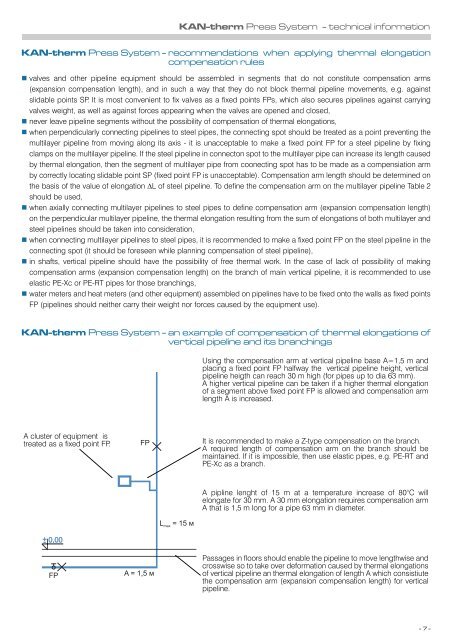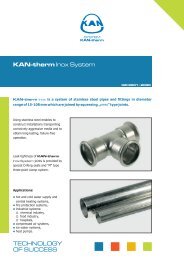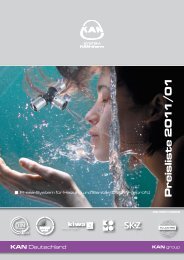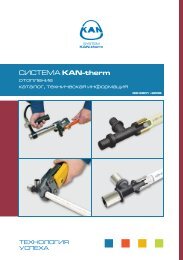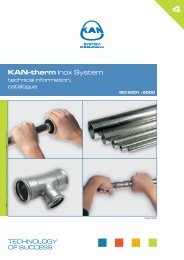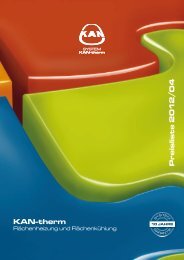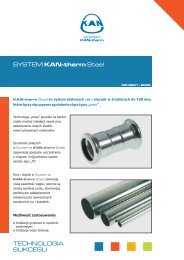KAN-therm Press System
KAN-therm Press System
KAN-therm Press System
Create successful ePaper yourself
Turn your PDF publications into a flip-book with our unique Google optimized e-Paper software.
<strong>KAN</strong>-<strong>therm</strong> <strong>Press</strong> <strong>System</strong> - technical information<br />
<strong>KAN</strong>-<strong>therm</strong> <strong>Press</strong> <strong>System</strong> - recommendations when applying <strong>therm</strong>al elongation<br />
compensation rules<br />
• valves and other pipeline equipment should be assembled in segments that do not constitute compensation arms<br />
(expansion compensation length), and in such a way that they do not block <strong>therm</strong>al pipeline movements, e.g. against<br />
slidable points SP. It is most convenient to fix valves as a fixed points FPs, which also secures pipelines against carrying<br />
valves weight, as well as against forces appearing when the valves are opened and closed,<br />
• never leave pipeline segments without the possibility of compensation of <strong>therm</strong>al elongations,<br />
• when perpendicularly connecting pipelines to steel pipes, the connecting spot should be treated as a point preventing the<br />
multilayer pipeline from moving along its axis - it is unacceptable to make a fixed point FP for a steel pipeline by fixing<br />
clamps on the multilayer pipeline. If the steel pipeline in connecton spot to the multilayer pipe can increase its length caused<br />
by <strong>therm</strong>al elongation, then the segment of multilayer pipe from coonecting spot has to be made as a compensiation arm<br />
by correctly locating slidable point SP (fixed point FP is unacceptable). Compensation arm length should be determined on<br />
the basis of the value of elongation ΔL of steel pipeline. To define the compensation arm on the multilayer pipeline Table 2<br />
should be used,<br />
• when axially connecting multilayer pipelines to steel pipes to define compensation arm (expansion compensation length)<br />
on the perpendicular multilayer pipeline, the <strong>therm</strong>al elongation resulting from the sum of elongations of both multilayer and<br />
steel pipelines should be taken into consideration,<br />
• when connecting multilayer pipelines to steel pipes, it is recommended to make a fixed point FP on the steel pipeline in the<br />
connecting spot (it should be foreseen while planning compensation of steel pipeline),<br />
• in shafts, vertical pipeline should have the possibility of free <strong>therm</strong>al work. In the case of lack of possibility of making<br />
compensation arms (expansion compensation length) on the branch of main vertical pipeline, it is recommended to use<br />
elastic PE-Xc or PE-RT pipes for those branchings,<br />
• water meters and heat meters (and other equipment) assembled on pipelines have to be fixed onto the walls as fixed points<br />
FP (pipelines should neither carry their weight nor forces caused by the equipment use).<br />
<strong>KAN</strong>-<strong>therm</strong> <strong>Press</strong> <strong>System</strong> - an example of compensation of <strong>therm</strong>al elongations of<br />
vertical pipeline and its branchings<br />
Using the compensation arm at vertical pipeline base A=1,5 m and<br />
placing a fixed point FP halfway the vertical pipeline height, vertical<br />
pipeline heigth can reach 30 m high (for pipes up to dia 63 mm).<br />
A higher vertical pipeline can be taken if a higher <strong>therm</strong>al elongation<br />
of a segment above fixed point FP is allowed and compensation arm<br />
length A is increased.<br />
A cluster of equipment is<br />
treated as a fixed point FP.<br />
It is recommended to make a Z-type compensation on the branch.<br />
A required length of compensation arm on the branch should be<br />
maintained. If it is impossible, then use elastic pipes, e.g. PE-RT and<br />
PE-Xc as a branch.<br />
A pipline lenght of 15 m at a temperature increase of 80°C will<br />
elongate for 30 mm. A 30 mm elongation requires compensation arm<br />
A that is 1,5 m long for a pipe 63 mm in diameter.<br />
Passages in floors should enable the pipeline to move lengthwise and<br />
crosswise so to take over deformation caused by <strong>therm</strong>al elongations<br />
of vertical pipeline an <strong>therm</strong>al elongation of length A which consistiute<br />
the compensation arm (expansion compensation length) for vertical<br />
pipeline.<br />
- 7 -


